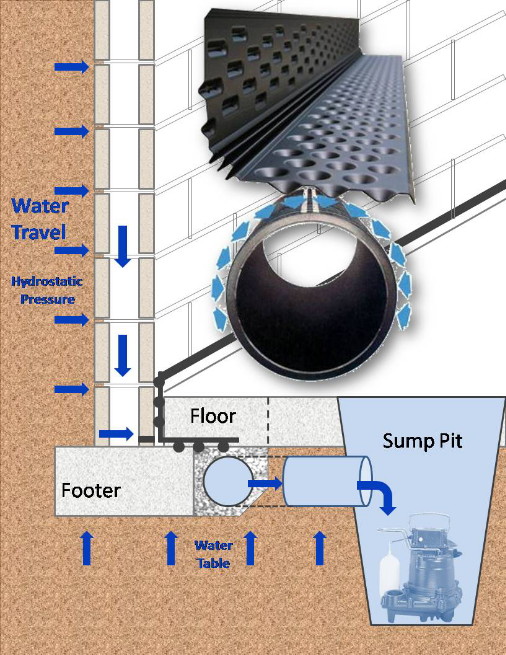The Crucial Guide to Preserving Your French Drain for Lasting Performance
Preserving your French drain is crucial to its effectiveness and your home's security. Normal checks can save you from pricey repair services and water damage. You'll need to know what indications to look for and just how usually to check your system. And also, understanding the cleansing process can make a substantial distinction. Let's discover the important actions for ensuring your drain works well for several years ahead.
Understanding the Feature of a French Drainpipe
A French drainpipe is a critical component in managing water around your home. It directs excess water away from your foundation, preventing flooding and damage. When hefty rain drops, the drain accumulates water through a perforated pipe buried in gravel. This system permits water to move easily, reducing stress on your cellar wall surfaces and reducing the danger of leaks.You might question just how it functions in method. As water saturates the dirt, gravity draws it toward the drain. The perforated pipe captures this water, moving it to a designated water drainage location or storm drain. This procedure maintains your lawn dry and secures your home's structural integrity.Understanding exactly how a French drain functions is crucial to valuing its value. By effectively transporting water away, it aids preserve a safe and dry living atmosphere. So, keeping your French drain in leading problem warranties you stay clear of expensive fixings down the line.
Routine Assessments: What to Seek
When you're checking your French drainpipe, beginning by looking for any clogs that may be blocking water flow. Focus on indicators of surface erosion around the drainpipe, as this can show potential issues. Regular evaluations will certainly help keep your drainage system functioning efficiently.
Obstructed Drain Analysis
Exactly how can you tell if your French drain is clogged? First, expect water merging in your backyard, especially after heavy rainfall. That's a red flag if you observe areas where water accumulates rather of draining pipes. You need to likewise examine the drainpipe electrical outlet; if water isn't spurting as it should, there's most likely an obstruction. Listen for unusual gurgling audios, which can show trapped air. In addition, check the drainpipe's surface for any type of vegetation growth, as roots can infiltrate and block the system. Lastly, if you scent moldy smells, it could direct to stationary water brought on by a clog. Routinely reviewing these indications can aid you keep your French drainpipe effectively and stop expensive repairs.
Surface Area Erosion Examine

Cleansing Your French Drainpipe: Step-by-Step Guide
Cleaning your French drain is necessary for keeping it functioning correctly. You'll need some certain devices and a clear process to guarantee whatever runs smoothly. Allow's go through the steps and tips for preserving your drainpipe properly.
Devices You'll Need
To take on the task of cleansing your French drain effectively, you'll intend to collect a few vital tools. First, get a tough set of handwear covers to safeguard your hands from debris and sharp objects. A little shovel or trowel will help you get rid of dirt or clogs around the drainpipe. For cleaning out the interior, a plumber's serpent or a high-pressure water nozzle can be extremely helpful. You'll additionally require a pail for collecting any debris you take out. Having a yard pipe on hand will make it less complicated to wash out the drainpipe and ensure it's streaming efficiently. With these devices prepared, you'll be set for an extensive cleansing session!
Cleansing Process Steps
Beginning by assessing the location around your French drainpipe for any kind of visible particles or blockages. Remove leaves, branches, or dirt that might obstruct water circulation. Next, check the inlet and electrical outlet areas; clear any kind of blockages to guarantee proper drainage. Utilize a garden hose pipe to purge the drain, guiding water into the inlet. This aids dislodge any kind of collected sludge or sediment. Think about using a plumbing technician's serpent to damage them up if you observe consistent blockages. After cleaning, inspect the gravel around the drainpipe; replenish it if it's gotten rid of. Confirm the drain covers are intact and securely in place to prevent particles from going into. Routine cleaning keeps your French drain operating effectively.
Maintenance Frequency Tips
While regular upkeep is essential for your French drain's longevity, knowing just how commonly to keep it can make all the distinction. Ideally, you need to inspect your French drainpipe a minimum of two times a year, ideally in spring and fall. After hefty rains or snowmelt, check for blockages or particles. If you notice any kind of standing water, it's time to clean your drain.In areas with hefty vegetation, even more regular maintenance-- concerning every three months-- might be necessary. In addition, take into consideration cleansing your French drainpipe after major storms or if you observe water merging in your lawn. By remaining positive, you'll assure your French drain features properly and shields your residential property from water damage. Routine checks will save you time and money over time.
Recognizing Usual Problems and Their Solutions
It's crucial to determine common issues with your French drain and carry out efficient solutions when you observe water pooling in your great site backyard or damp areas in your cellar. One frequent problem is clogging, usually triggered by particles like leaves or debris. To fix this, you can use a pipes serpent or a high-pressure water jet to clear blockages.Another issue may be inappropriate slope. If your drain isn't sloped appropriately, water won't stream far from your home. You can readjust the slope by excavating and repositioning the drainpipe pipe.Lastly, check for damages or splits in the drainpipe itself. Replacing the damaged sections is essential for peak performance if you find any type of. By resolving these concerns promptly, you'll help assure that your French drain proceeds to function properly, safeguarding your building from water damages and keeping a completely dry, secure environment.
Seasonal Maintenance Tips for Your French Drainpipe
Addressing usual issues with your French drainpipe is simply the initial step in assuring its lasting performance. Seasonal upkeep is important for peak efficiency. In the spring, clear away leaves and particles that may have collected during winter. Look for any kind of clogs in the outlet or catch basin, as water requires a clear path to stream freely.During summer season, examine your drainpipe for any indicators of clearing up or shifting soil. Make specific it's still level and functioning properly. As fall approaches, clear out any kind of dropped entrusts to stop obstructions prior to wintertime arrives.In winter, expect freezing temperature levels. Make sure your drainpipe isn't at danger of freezing if you live in a chilly environment. Shielding revealed pipes can help. Routine checks and timely upkeep can avoid pricey repair services and keep your French drain functioning efficiently year-round. Stay aggressive and more information delight in comfort knowing your drainage system is in excellent form!
When to Contact an Expert
When to call in an expert can conserve you time and protect against further damage to your French drain, recognizing. It's a clear sign that your drainpipe may be obstructed or damaged if you notice consistent standing water in your backyard. Do not ignore strange odors, as they can indicate sewage backup or decay, which needs immediate attention.If you discover that your drainpipe isn't functioning correctly after attempts to clean or maintain it, it's time to connect for specialist help. Additionally, if you're unclear about the underlying issues or do not have the required tools, employing a professional can supply tranquility of mind.Finally, if your French drainpipe is old or has actually experienced significant wear and tear, specialist assessment can figure out whether fixings or total replacement is required. Trust the specialists to guarantee your drainage system works effectively for years to come.
Tips for Protecting Against Future Drainage Problems
To maintain your French drainpipe working efficiently, on a regular basis inspecting and keeping it can make all the difference. Begin by clearing particles, leaves, and dust from the surface area and drainpipe openings. This protects against blockages that can lead to water backup. Check the gravel around the drainpipe; if it's compacted or worn down, think about including fresh crushed rock to keep suitable flow.Next, divert water far from your drain by making certain downspouts and gutters are clear and guiding water at the very least 3 feet far from your structure. Routinely inspect for any indications of damage or sagging. If you see problems, resolve them immediately.Finally, think about mounting a filter or a catch basin to trap larger debris before it enters the drainpipe. By staying proactive with these pointers, you'll reduce the danger of future water drainage issues and maintain your French drain in leading form.
Often Asked Concerns
The length of time Does a French Drain Usually Last?
A French drainpipe commonly lasts around 30 to 40 years, depending on the materials utilized and maintenance (Portland French Drain). If you maintain up with normal checks, you can prolong its life-span also further
Can I Set Up a French Drainpipe Myself?
Yes, you can mount a French drain yourself if you have actually obtained the right tools and knowledge. Just make sure to plan meticulously, comply with neighborhood regulations, and guarantee appropriate water drainage to stay clear of future concerns.
What Products Are Used in a French Drainpipe?
You'll need perforated pipeline, crushed rock, landscape textile, navigate to this website and a solid water drainage pipe for your French drainpipe. These materials aid redirect water effectively, avoiding flooding and keeping your home risk-free and dry from water damages.

Is a Permit Required to Install a French Drain?
You'll likely need a permit to install a French drain, depending on local regulations. Check with your municipality to guarantee you abide by any kind of essential standards and stay clear of prospective problems during installation.
What Are the Costs Linked With French Drainpipe Upkeep?
Preserving a French drain normally costs between $100 and $500 each year. You'll require to think about costs for cleaning, repair work, and inspections. Regular upkeep assists prevent bigger guarantees and expenditures your system operates effectively for many years - Portland French Drain. When you're checking your French drain, beginning by inspecting for any obstructions that may be obstructing water circulation. By staying proactive, you'll assure your French drainpipe functions successfully and secures your home from water damage. When you see water pooling in your backyard or damp areas in your cellar, it's important to recognize common problems with your French drain and implement efficient solutions. You can change the incline by excavating and rearranging the drain pipe.Lastly, check for damages or fractures in the drainpipe itself. Examine the gravel around the drain; if it's compressed or worn down, take into consideration including fresh crushed rock to maintain ideal flow.Next, divert water away from your drain by making certain gutters and downspouts are clear and routing water at least 3 feet away from your structure
 Tony Danza Then & Now!
Tony Danza Then & Now! Amanda Bynes Then & Now!
Amanda Bynes Then & Now! Tahj Mowry Then & Now!
Tahj Mowry Then & Now! Tina Majorino Then & Now!
Tina Majorino Then & Now! Ryan Phillippe Then & Now!
Ryan Phillippe Then & Now!